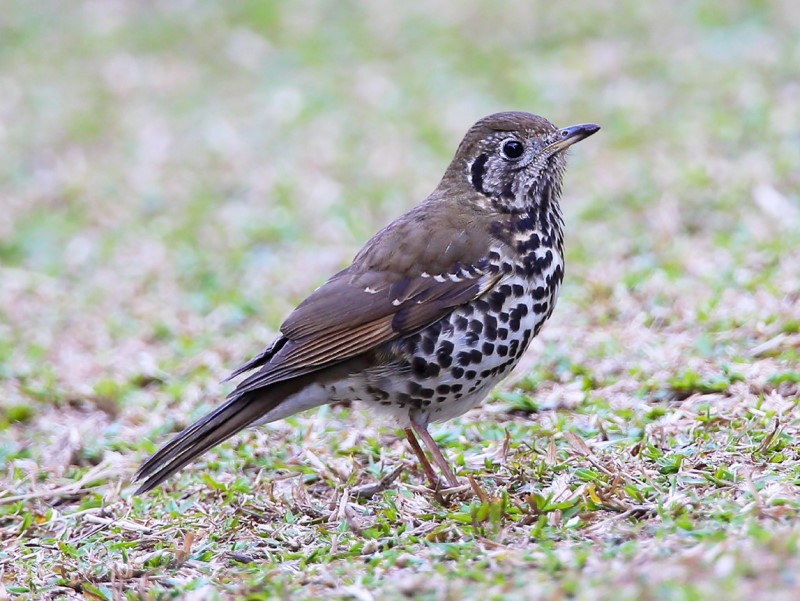Chinese Thrush Turdus mupinensis 寶興歌鶇
Category 1. Accidental in winter.
IDENTIFICATION

Feb. 2014, Michelle and Peter Wong. First-winter.
23 cm. Small to medium size thrush with extensive large dark brown spotting on underparts as far as the vent, a broad dark crescent behind the ear coverts and a less obvious dark line down from the eye. The upperparts are mid brown with darker feather centres, while the face is mealy greyish producing a capped effect. There is an ill-defined though broad dark malar bordering a whitish throat, while the ground colour to the chest and flanks is buffish. The flight feathers are edged warmer brown. The legs are pinkish and the bill greyish. First-winter birds have broad white tips to the wing coverts in fresh plumage.
VOCALISATIONS
Non-song vocalisations of the type likely to be heard in HK are unknown. The song is a series of short phrases mostly comprising pure notes lacking any harshness. There is no repetition from phrase to phrase. The delivery is rather slow, except for the occasional hurried flourish.
DISTRIBUTION & HABITAT PREFERENCE
All records have occurred in closed-canopy shrubland and forest or forest edge.
OCCURRENCE
Records have occurred in the period 18 November to 24 March:
2004: one trapped at Kadoorie ARC on 18 November.
2006: one on Po Toi from 16 February to 24 March.
2012: one on Po Toi on 5 December.
2014: one on The Peak from 17 January to 1 February.
2017: one at Shing Mun reservoir during 12-18 December.
BEHAVIOUR, FORAGING & DIET
Typically, rather unobtrusive and shy, but at times easy to see, especially during cold weather, much like other thrushes.
RANGE & SYSTEMATICS
Monotypic. A Chinese endemic species with very few records outside the country. Breeds in central China from the eastern and southeastern edges of the Qinghai-Tibet plateau east to the Qinling Mountains and northeast to the Beijing area (Liu and Chen 2021), where it is a scarce and local breeder in the mountains, a passage migrant in lowland areas, but rare in winter (Birding Beijing 2020). Non-breeding season records have occurred as far east as islands off the west coast of South Korea south to Taiwan. Hong Kong records are at the southern limit of its recorded occurrence.
CONSERVATION STATUS
IUCN: Least Concern. Population trend stable.
Birding Beijing. 2020. The Status of the Birds of Beijing. https://birdingbeijing.com/the-status-of-the-birds-of-beijing/ (accessed 29 May 2021).
Liu, Y. and S. H. Chen (eds) (2021). The CNG Field Guide to the Birds of China (in Chinese). Hunan Science and Technology Publication House.

